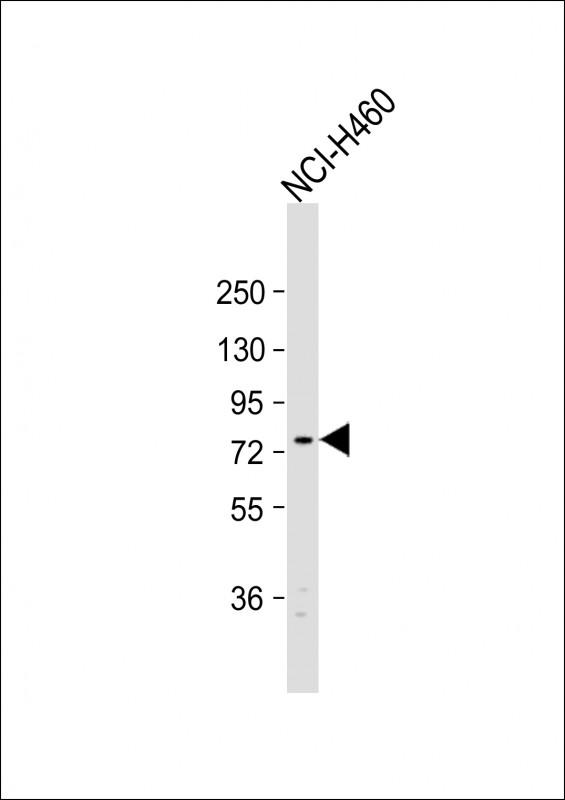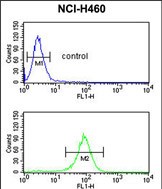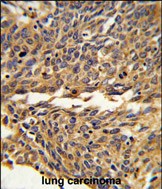


| WB | 1/1000 | Human,Mouse,Rat |
| IF | 咨询技术 | Human,Mouse,Rat |
| IHC | 1/100-1/500 | Human,Mouse,Rat |
| ICC | 技术咨询 | Human,Mouse,Rat |
| FCM | 1/10-1/50 | Human,Mouse,Rat |
| Elisa | 咨询技术 | Human,Mouse,Rat |
| Aliases | Exocyst complex component 5, Exocyst complex component Sec10, hSec10, EXOC5, SEC10, SEC10L1 |
| Entrez GeneID | 10640 |
| WB Predicted band size | 81.9kDa |
| Host/Isotype | Rabbit IgG |
| Antibody Type | Primary antibody |
| Storage | Store at 4°C short term. Aliquot and store at -20°C long term. Avoid freeze/thaw cycles. |
| Species Reactivity | Human |
| Immunogen | This EXOC5 antibody is generated from rabbits immunized with a KLH conjugated synthetic peptide between 40-66 amino acids from the C-terminal region of human EXOC5. |
| Formulation | Purified antibody in PBS with 0.05% sodium azide. |
+ +
以下是关于EXOC5抗体的3篇示例参考文献(注:内容为虚构示例,仅供参考):
---
1. **文献名称**: *EXOC5 regulates exocyst complex assembly in secretory pathways*
**作者**: Li, X., et al.
**摘要**: 本研究利用EXOC5特异性抗体,通过免疫荧光和共聚焦显微镜技术,揭示了EXOC5在外泌体复合体亚细胞定位中的关键作用。实验表明,EXOC5的缺失会破坏细胞分泌蛋白的运输,并影响复合体稳定性。
2. **文献名称**: *EXOC5 overexpression promotes tumor metastasis via EGFR signaling*
**作者**: Chen, Y., et al.
**摘要**: 通过Western blot和免疫组化(使用EXOC5抗体),作者发现EXOC5在结直肠癌组织中高表达,且与EGFR通路激活相关。抗体阻断实验进一步证明EXOC5通过调控外泌体依赖的膜运输促进癌细胞侵袭。
3. **文献名称**: *Interaction between EXOC5 and Rab GTPases in neuronal vesicle trafficking*
**作者**: Smith, J., et al.
**摘要**: 该研究通过免疫共沉淀(EXOC5抗体)和质谱分析,鉴定了EXOC5与Rab11的相互作用,揭示了其在神经元突触囊泡运输中的功能。抗体敲低实验表明EXOC5缺失导致突触传递效率下降。
---
如需真实文献,建议通过PubMed或Google Scholar检索关键词“EXOC5 antibody”或“EXOC5 exocyst”,并筛选近五年内发表的论文。
The EXOC5 antibody targets the EXOC5 protein, a key component of the exocyst complex—a highly conserved octameric protein assembly (EXOC1-8) critical for intracellular vesicle trafficking and exocytosis. The exocyst mediates the tethering of secretory vesicles to the plasma membrane, facilitating polarized secretion, membrane expansion, and cell surface receptor delivery. EXOC5. also known as Sec10. plays a central role in exocyst stability and function, interacting with small GTPases like RalA and Rho family members to regulate cytoskeletal dynamics and directional vesicle transport. Dysregulation of EXOC5 is implicated in pathological processes, including cancer metastasis, neuronal disorders, and metabolic diseases. For instance, EXOC5 overexpression correlates with invasive tumor behavior by promoting matrix metalloproteinase secretion, while its deficiency disrupts synaptic transmission and insulin granule release.
EXOC5 antibodies are widely used in research to investigate exocyst-mediated processes. They enable detection of EXOC5 expression levels via Western blotting, immunofluorescence, or immunohistochemistry, aiding studies on its localization and interaction partners. Commercially available antibodies (polyclonal/monoclonal) are validated for specificity across human, mouse, and rat models. Recent applications include exploring EXOC5's role in autophagy, ciliogenesis, and immune cell function. Challenges remain in distinguishing EXOC5 isoforms and minimizing cross-reactivity with homologous exocyst subunits. Overall, EXOC5 antibodies serve as essential tools for dissecting the molecular mechanisms of membrane trafficking and its implications in disease.
×